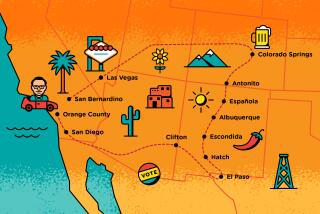Survey Finds a Gulf of Differences Along U.S.-Mexico Border
- Share via
The U.S.-Mexico border is often described as home to a unique, transnational society. But a new survey of Americans and Mexicans who live along it suggests the contrary: Despite living within a few miles of each other, American and Mexican border dwellers are very different.
The survey, based on interviews with about 2,000 residents on both sides of the U.S.-Mexico line, found that people who live near the border have a few common concerns--the environment, for example--but are otherwise as different as their respective nations.
“This strongly suggests that there is not a unique border community,” said Rodolfo de la Garza, a University of Texas at Austin professor and research director for the Tomas Rivera Policy Institute, a Claremont think tank.
Despite what he called a “romantic” idea of a bicultural border society, he said the two communities “by and large . . . live separate lives.”
Among the survey’s findings were that residents on the U.S. side share American viewpoints on immigration and social issues, while those living on the Mexican side hold Mexican views.
For example, on the issue of whether the NAFTA trade pact should allow greater flow of workers across the border, 90% of Mexicans questioned thought it should, showing a desire for greater access to the U.S. job market, while only 60% of American respondents did.
Among Mexicans, 81% rated crime as one of their most serious concerns, while only 25% of Americans did. American respondents were more worried about social service issues, such as health care.
The survey interviewed residents of towns from Matamoros to Tijuana on the Mexican side, and from Brownsville, Texas, to San Ysidro, Calif., on the U.S. side.
It was commissioned by the Mexican state of Tamaulipas and was conducted in partnership with the Autonomous University of Tamaulipas.
Jerry L. Polinard, a political science professor at the University of Texas-Pan American, near McAllen, said the survey results are consistent with prior research into border cultures, especially studies suggesting rapid assimilation among Mexican Americans on the U.S. side.
“The general business community down here thinks the river is not a border, it’s just a river,” he said. “But a sense of that economic relationship does not translate to a cultural identity.”
Besides being poorer and less educated, on average, than their American neighbors, the majority of Mexicans interviewed were exclusively Spanish speakers.
American border residents, on the other hand, were more likely to speak Spanish as well as English, probably reflecting large numbers of Americans of Mexican descent who learned Spanish from immigrant families.
Irasema Coronado, a political science professor at the University of Texas at El Paso, said that some of the differences captured in the survey may reflect differences in wealth and education on the two sides, rather than in nationality. “There is cultural separateness” in the borderlands, she said, “but also a vast class difference.”
Carlos Vasquez, president of the San Ysidro Business Assn. and a local hotel operator, disputed the notion that the border remains a culturally divided place.
“You can almost say [the border] is a different country--different than the U.S. and different than Mexico,” he said.
Vasquez personifies some of the complexities of border identity: The son of Mexican immigrants, he is so completely bilingual that Spanish and English “are kind of like the same to me,” he said.
Yet he is also the product of a thoroughgoing American upbringing. He graduated from San Diego State in political science, calls himself a moderate Republican, and rarely crosses the border.
Growing up in San Ysidro, he added, “you had a sense you didn’t belong to this culture, or the Mexican culture. You were kind of in between.”
More to Read
Sign up for Essential California
The most important California stories and recommendations in your inbox every morning.
You may occasionally receive promotional content from the Los Angeles Times.













